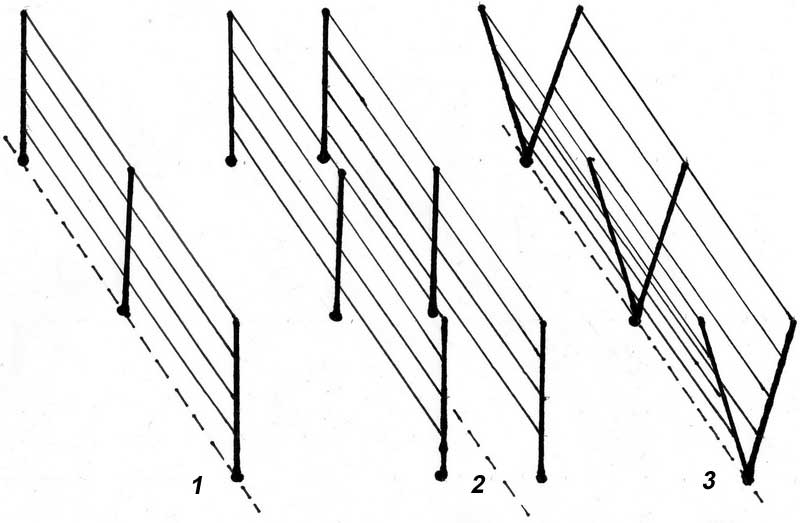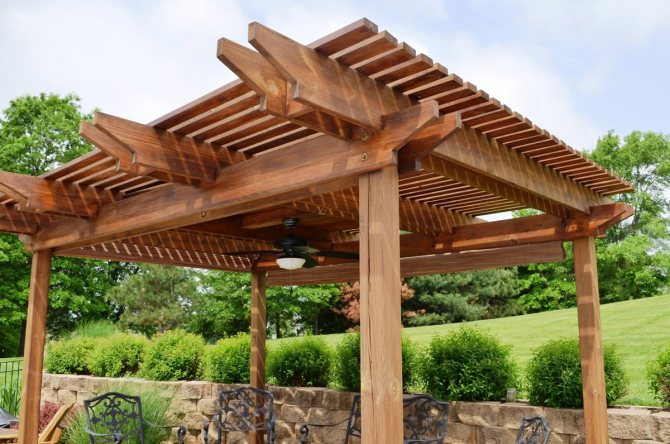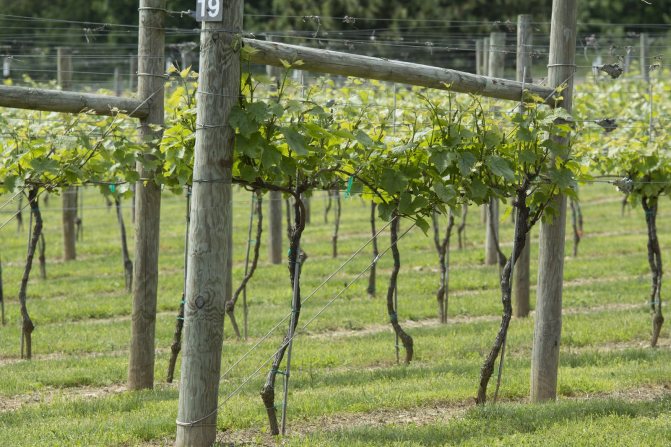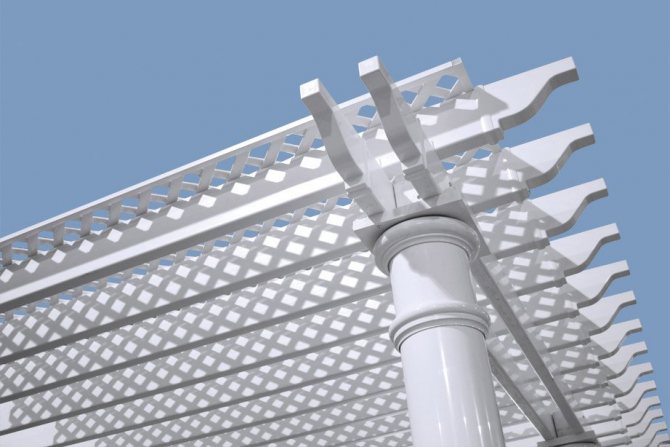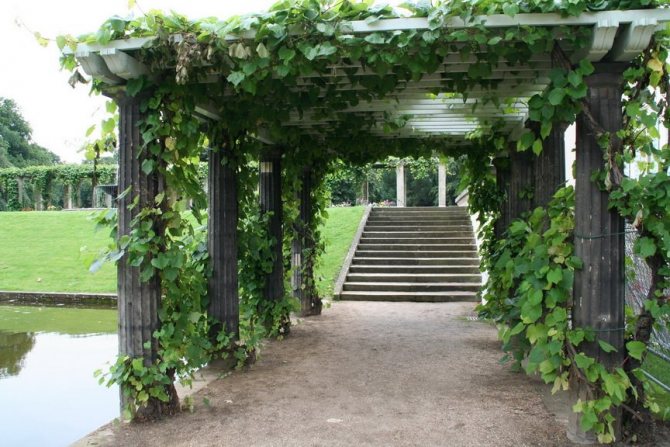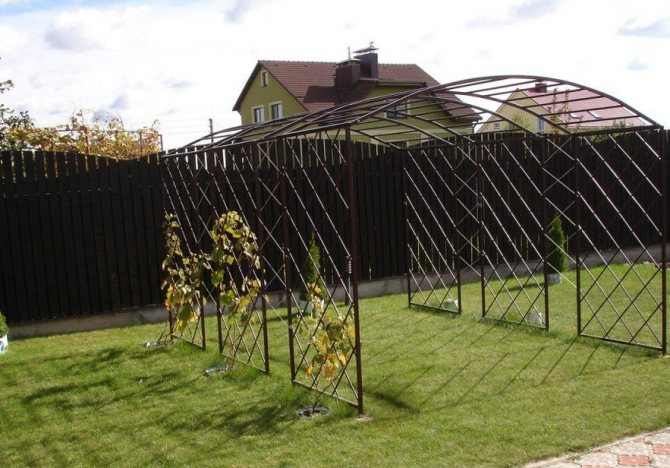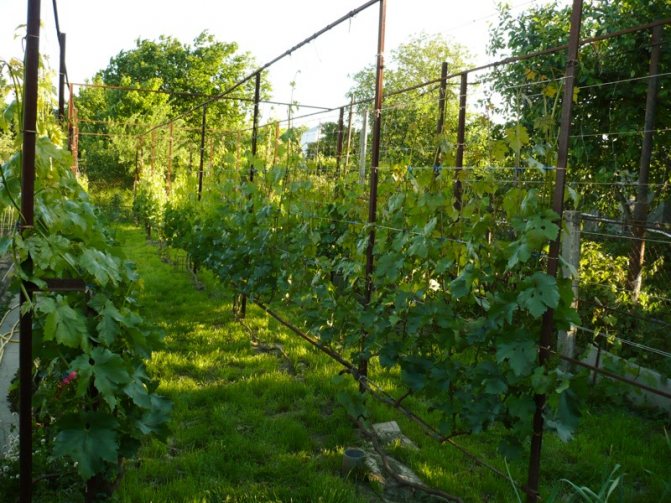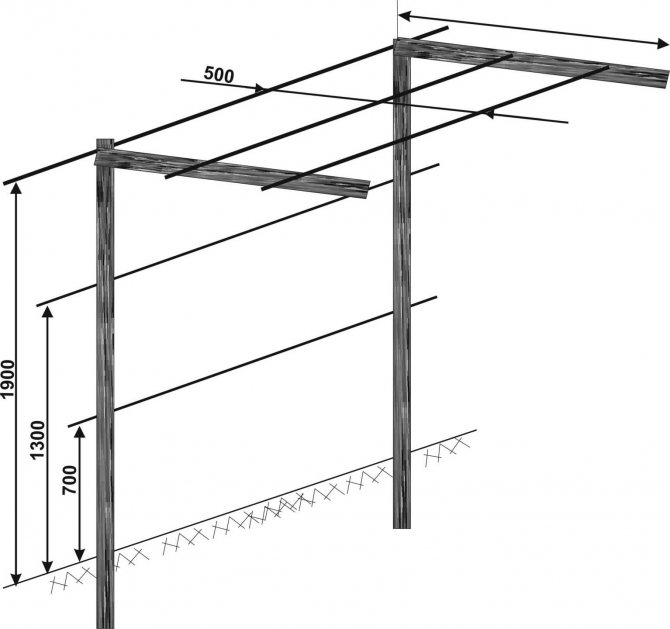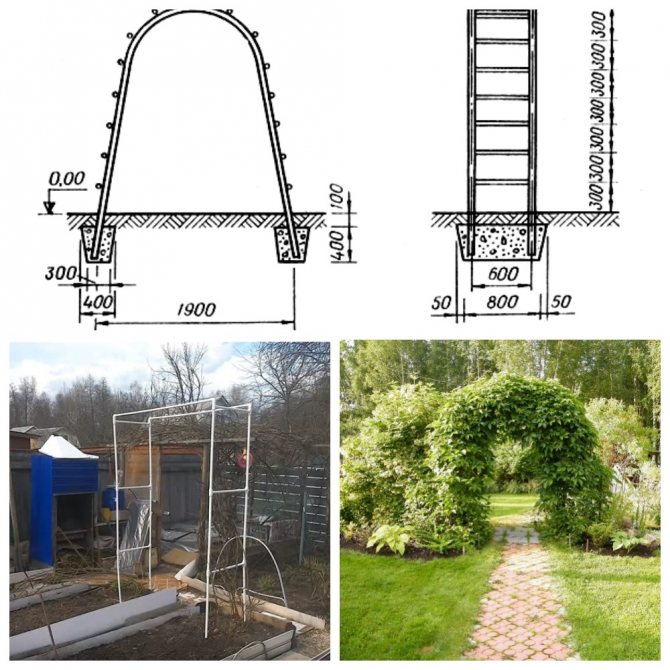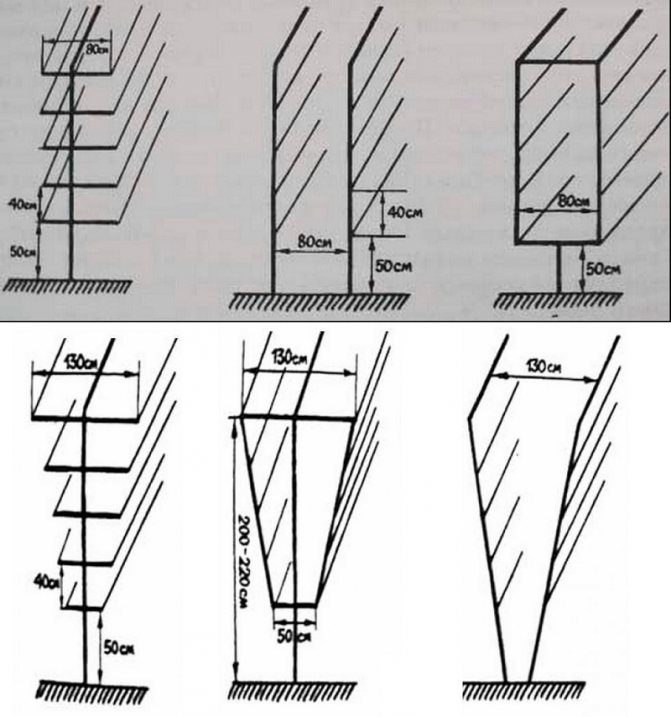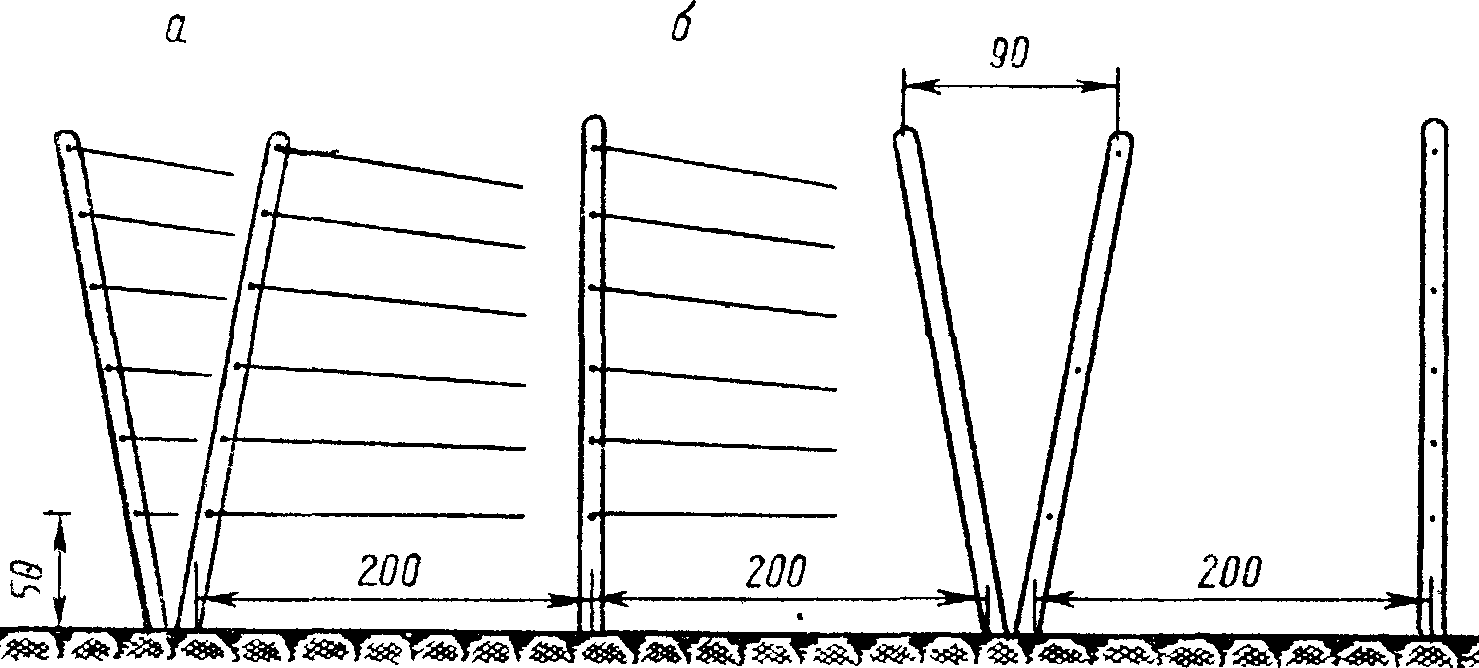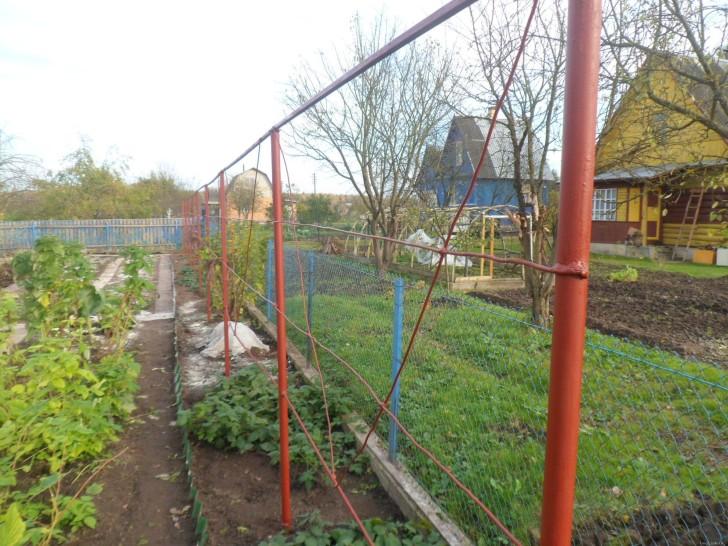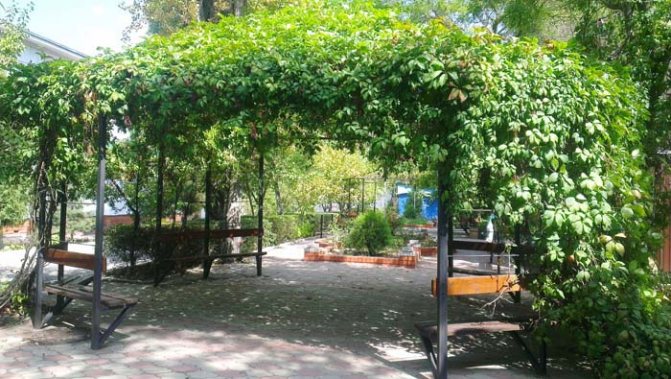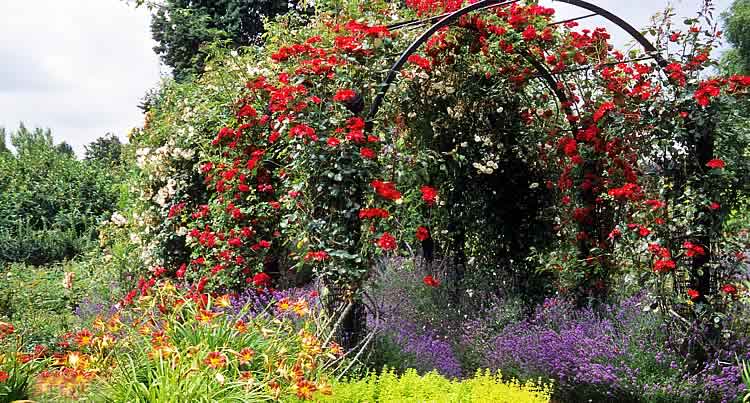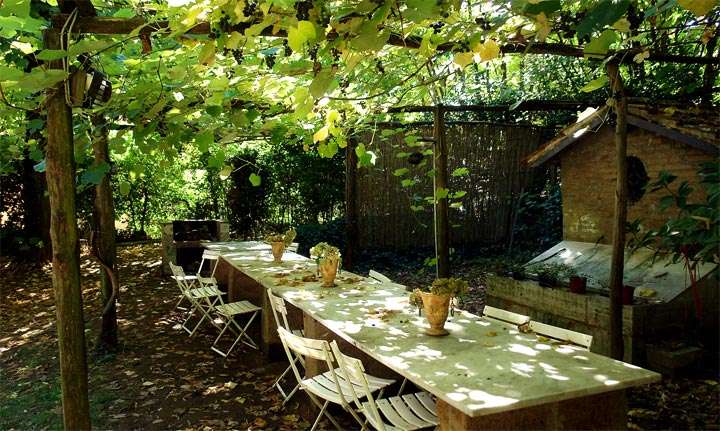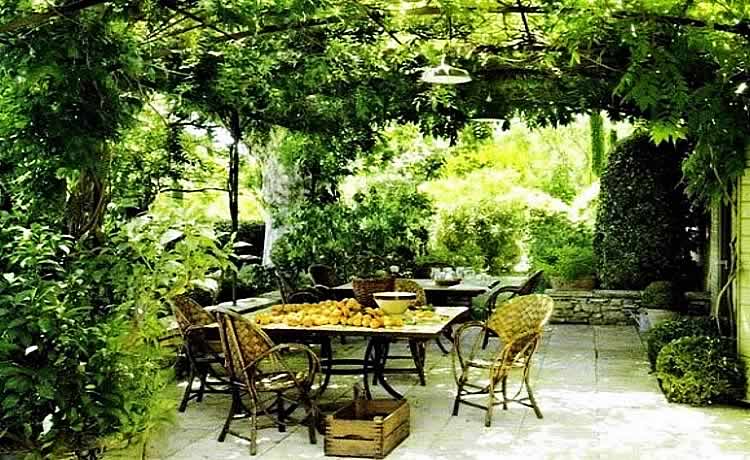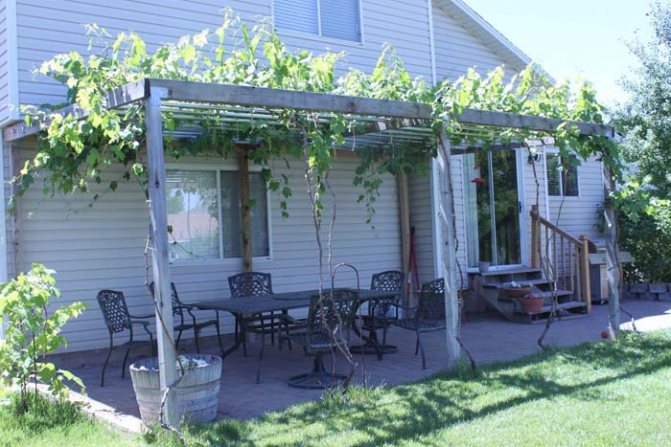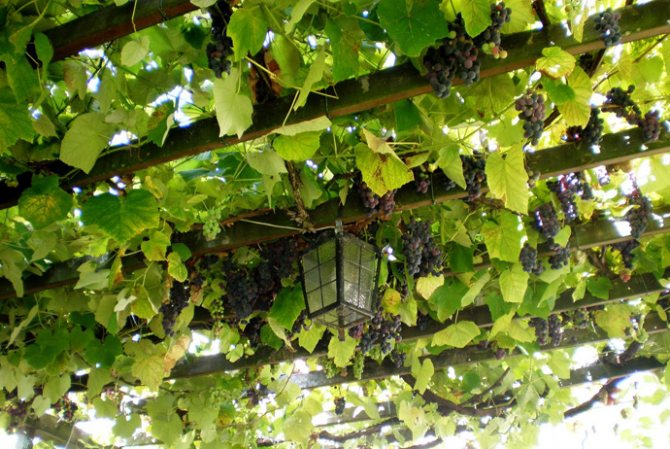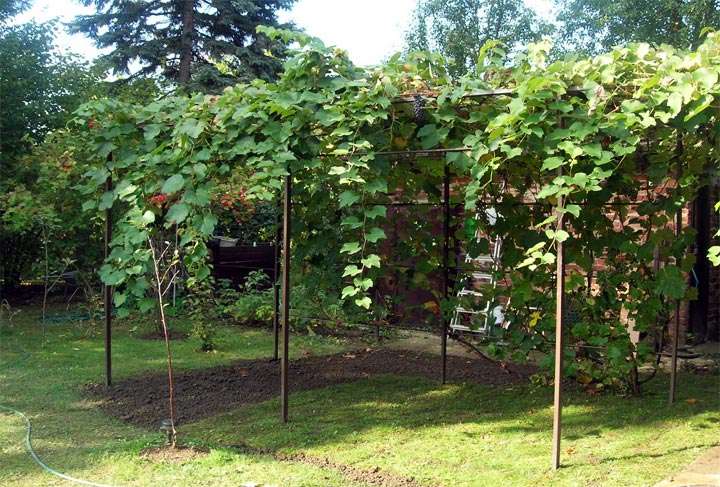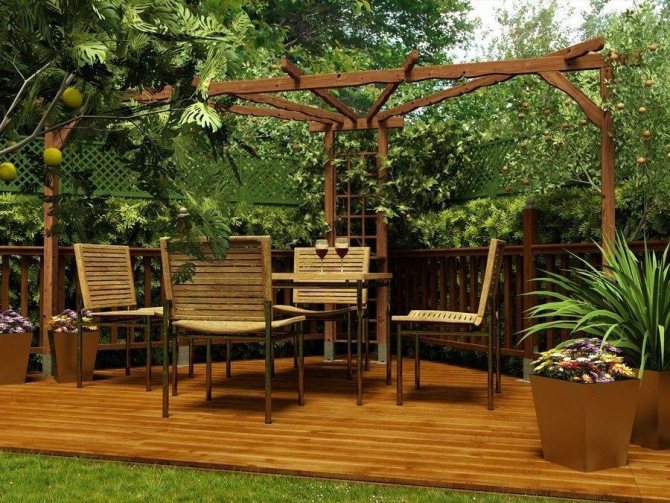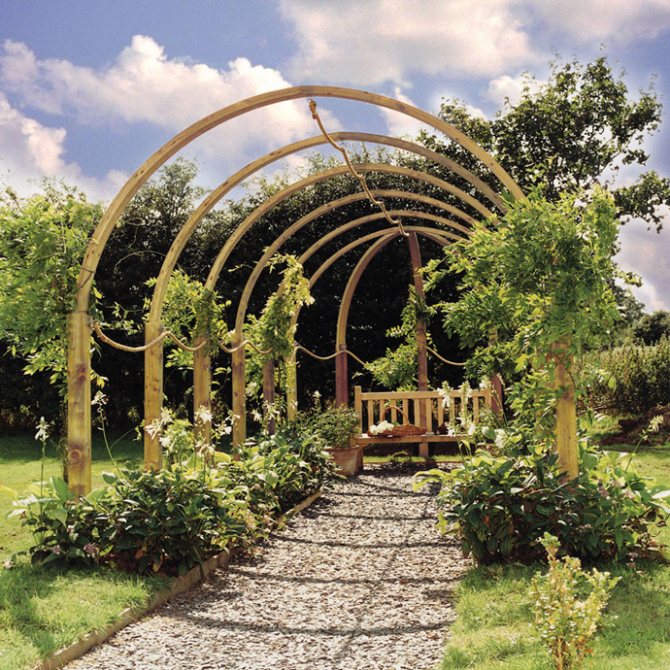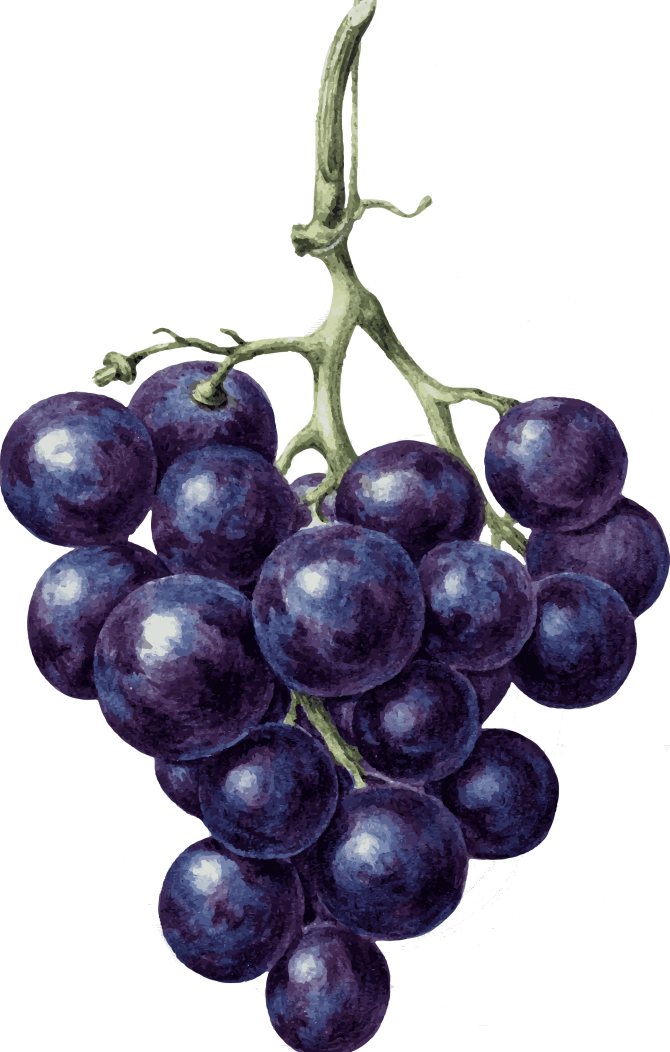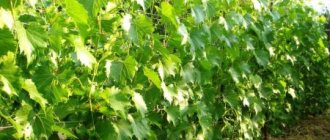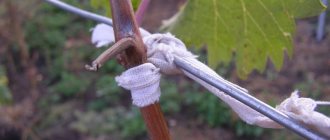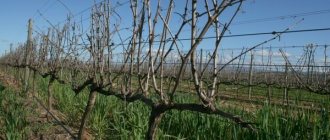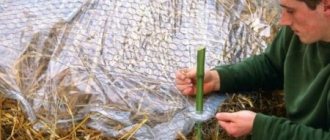Summer residents who grow grapes on their site, from their own experience, were able to convince themselves of the need to build the correct support. In this case, the plant does not fall to the ground, its leaves receive more light. This allows the grapes to develop harmoniously. Shoot yield will be higher when using the correct support.
A novice gardener should know what size of trellis for grapes will be optimal, as well as what types of such structures exist. In this case, growing the crop will be simple and fun. There will be no hassle with this.
Plant features
Setting up a vineyard is an interesting experience. This plant is a vine. It braids nearby plants with its stems to get more sunlight.
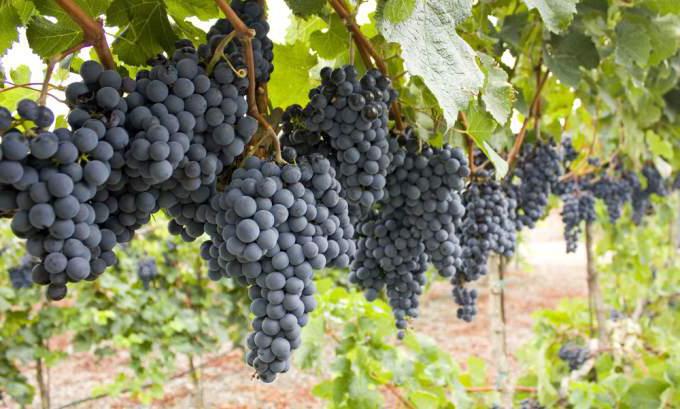
Grapes bear fruit well even in the middle climatic zone of our country. It is grown even in the suburbs. Special grape varieties are suitable for cold climates. Its berries will be smaller, but their taste and benefits will not diminish. Also summer residents grow decorative varieties of the presented plant.
Support for grapes should be installed in a well-lit area of the site. In this case, the plant will quickly braid the bars prepared for it with its green shoots. This will allow you to create a decorative composition, and in the fall to collect a chic harvest of grapes.
The advantage of the trellis
Forming a grape bush with a trellis has a number of advantages. This approach allows you to fully form the skeleton of the bush. This process must be carried out from the very first years of the life of the grapes. This tactic allows you to set a certain shape for a curly mass of vines.
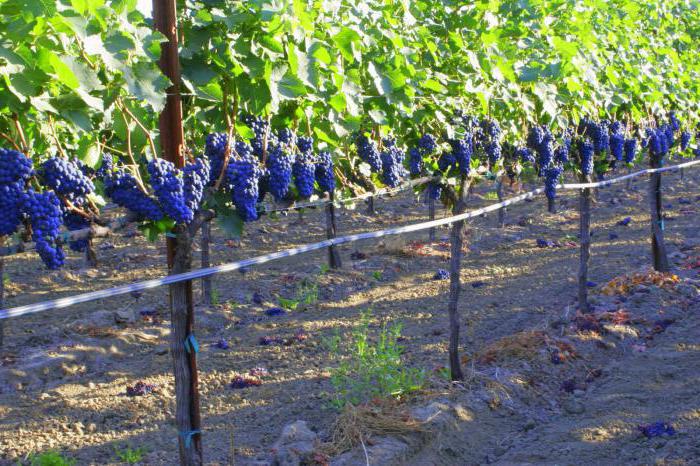

The trellis allows the shoots to be evenly distributed over the entire support plane. Shoots do not interfere with each other. In this case, the leaves receive more light. The grapes will catch the sun's rays with the entire surface of the leaf.
Tying grapes in the spring, pruning dry leaves will be done faster if there is such a support. Plant care will be faster and easier.
Growing away from the ground, the leaves are provided with good ventilation. This significantly reduces the likelihood of fungal diseases on the leaves, the appearance of rot.
Design features
The size of the trellis for grapes is determined based on considerations of comfortable plant care, as well as the type of support itself. To install it, you must choose the right place. This should be a well-lit, spacious area. Watering the plant should be comfortable. Light-loving plants or plants that are afraid of high humidity should not grow nearby.
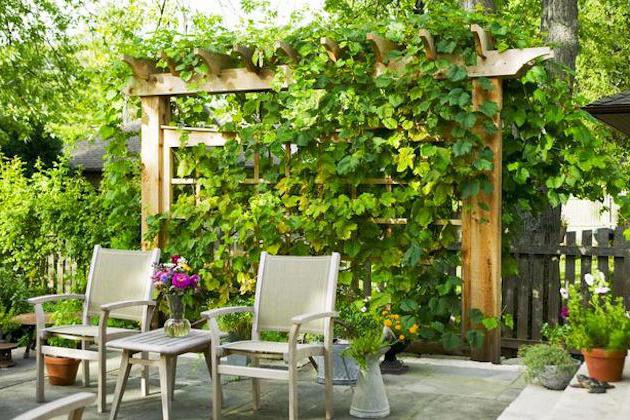

The rows of trellises are installed in the direction from north to south. The distance between the posts can be large. This will give the grapes the opportunity to grow over the years. The minimum distance between the posts should be about 2 m. Vegetable crops that prefer to grow in the shade can be planted nearby.
There are several options for arranging trellises. There are one-plane, two-plane and arched structures. The first option is the simplest. Two-plane supports require a lot of free space between the rows. In this case, other cultures will not be able to occupy free space.
Arched plant trellises are usually high in height. They are usually used for decorative purposes. Their size should be larger than the height of a person, so that you can walk under the arches.
Self-tying grapes to the trellis
The key to a good harvest and a beautiful look of supports is a competent garter of vines. How do you do it right?
Nuances of garter grapes:
- Those vines that have already borne fruit are best tied up in the first row (you can also partially in the second);
- You can place the vine obliquely (at an angle of 45 degrees) or horizontally;
- You need to fasten the branches tightly, but carefully, in order to prevent damage to the plant - this can be done with special clamps or ordinary wire.
It is not recommended to tie up the grapes vertically, since in this case only the upper bunches grow well.
Every master can make trellises for grapes, spending a little of his time on it. Given the variety of these structures, you can always choose just such a support that will take into account your capabilities and wishes. Thanks to this design, you will be able to grow fragrant and very tasty grapes.
Material
The material for the construction of the support can be different. Its posts can be wooden, metal. There are also plastic trellis for grapes. Supports are created from pipes or corners. The main requirement for the material is increased rigidity. The structure must be strong and reliable.
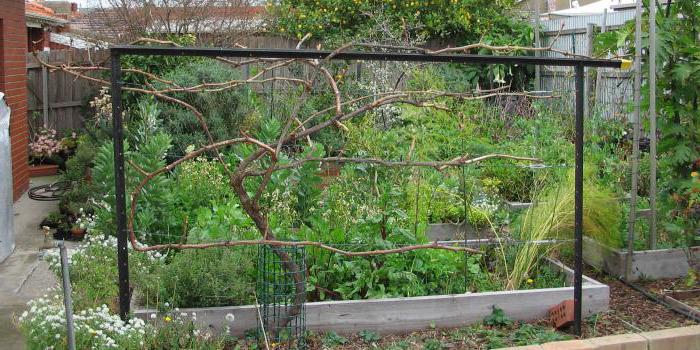

Today, plastic is the most demanded material that is used for the manufacture of tapestries. It is easy to install on site. Modern materials in this category have increased strength and low weight. In this case, the installation will be quick and will not require significant expenditures of time and effort.
Wooden structures require high-quality processing. Over time, they can begin to deteriorate. This also applies to metal arches. Rust can compromise structural integrity. Plastic is considered a durable, maintenance-free material.
How to make a pergola with your own hands ↑
It happens that novice builders, wanting to speed up the process, ask themselves the question, is it really necessary to build a pergola with their own hands step-by-step instructions with drawings? Why not get started right away, solving emerging problems right on the spot? In fact, for those who have been engaged in construction for a long time, and for novice craftsmen, a detailed technological scheme can save time, materials, and nerves.
As an example of making a pergola for a summer residence, a 2x3 wooden structure was taken. For its construction, you will need the following materials:
- steel water pipe 4 inches, 1 m long - 4;
- pillars 100x100x3000 - 4;
- longitudinal beams 50x150x4500 - 4;
- cross beams 40x100x3000 - 7;
- rail 40x40x4000 - 10;
- bolts М12х250 - 8;
- nuts with washers - 16;
- timber for decorative lattice 20x40 - based on the desired pattern.
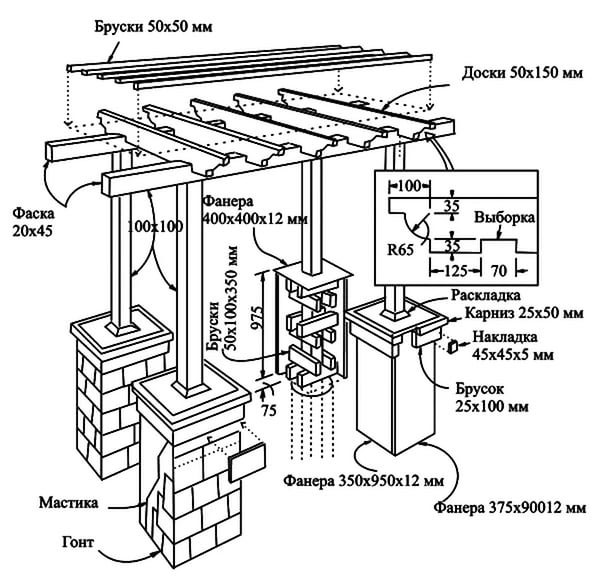

An example of a drawing of a pergola on brick supports
Before building a pergola, it is necessary to treat the wood with an antiseptic and water-repellent agent. Next, you need to follow the algorithm:
On a previously prepared site, make a rectangular marking and dig holes in the corners with a depth of 500–600 mm. Drive pipes into them and concrete. After complete drying, install 4 pillars with pre-ground bevels into the pipes.
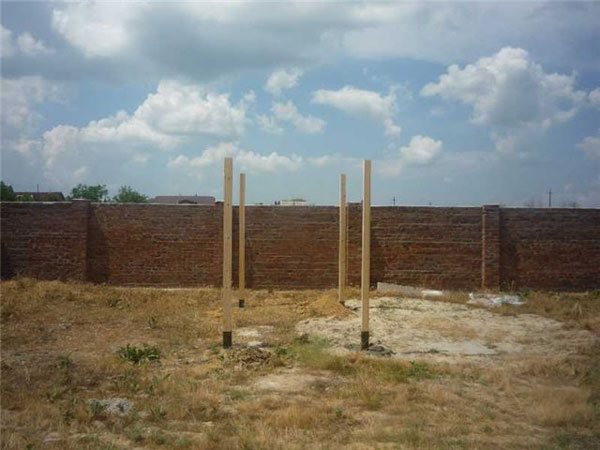

Base of pillars
Use a template and a circular saw or jigsaw to form curved ends at both ends of the crossbeams and longitudinal beams.
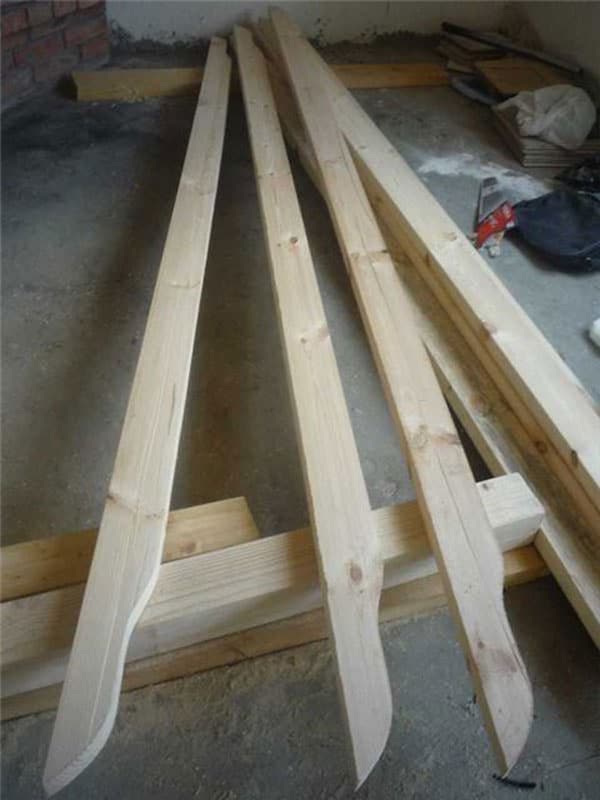

Shaped beams
Having verified the horizontal level, first fix the longitudinal beams with bolts on the paired pillars, then lay and attach the transverse ones, and on top of them - a counter-lattice of 40x40 slats.
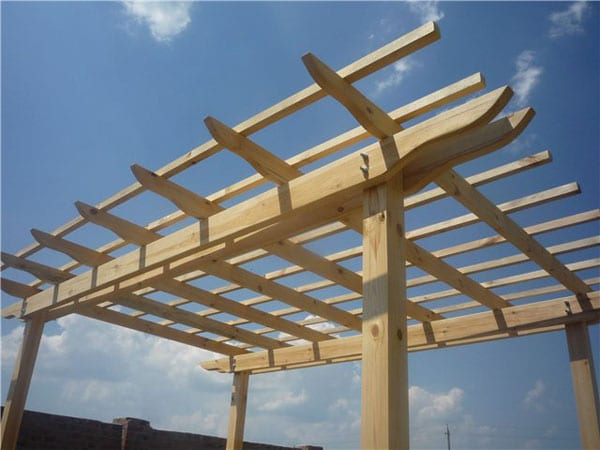

Arbor counter lattice
On the ground, knock down 2 frames for side trellises and stuff a straight or oblique lattice on them with nails.
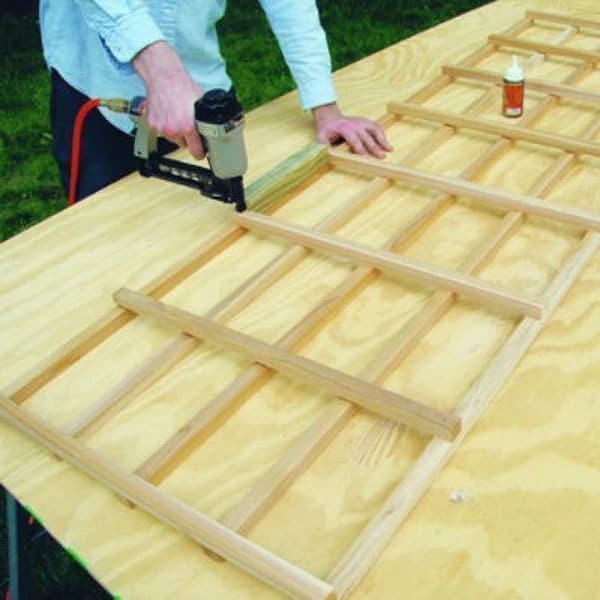

Assembling parts
Fix the frames and treat the product with a decorative tone or again with an antiseptic.
It is allowed to concrete the floor in advance, even before the installation of the pergola, or when it is ready. After the cement has finally set, you can start planting climbing plants so that they have time to braid the frame the next season.
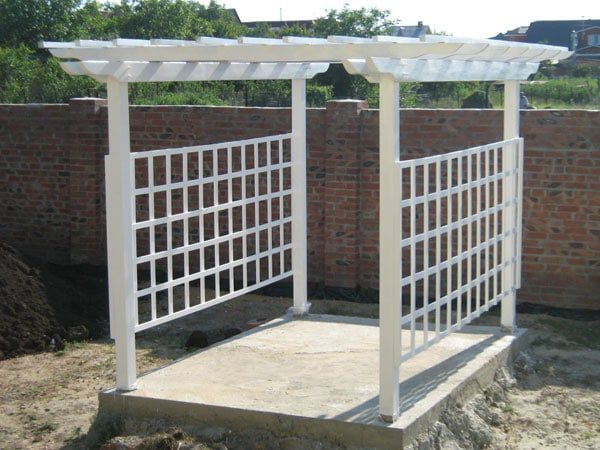

Antiseptic treatment
Wire
The support wire must be strong and not corroded. Grapes can grow for about 50 years. Therefore, it is better to choose high-quality materials once than to carry out repairs after several years.
The metal thread must have a high zinc content. This increases the service life of the wire by 3 times. The density of the metal should be about 230 g / m². Such material lengthens by only 5%. This is a good indicator that allows you to grow heavy branches of grapes on a trellis.
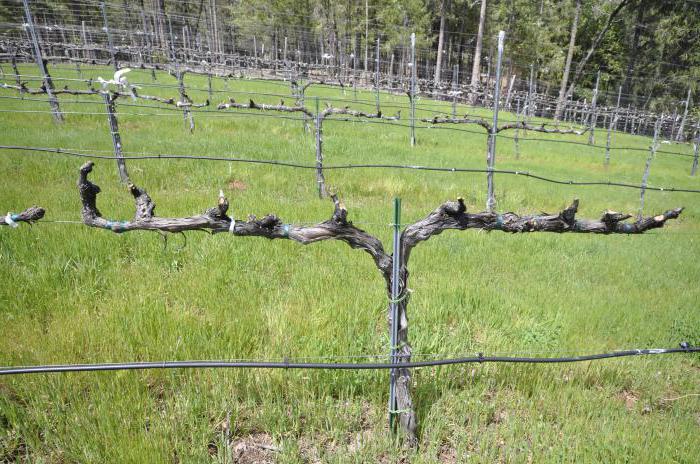

Also, the wire may contain carbon. It also has a positive effect on its durability. The thread does not rust, does not sag. It is extremely rare to pull it up.
The size
The size of the trellis for grapes should provide convenient plant care and harvesting. It is recommended to choose the diameter of pipes from 32 to 57 mm. The cross-section of the support pillars can be not only round, but also square, rectangular. Such designs are cheaper. In this case, it will be easier to assemble the structure.
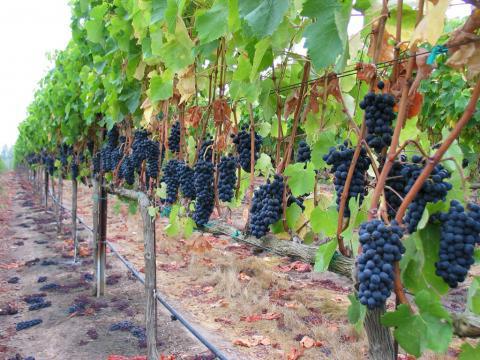

The optimum height for the trellis is considered to be a level of 2.2 m. This rule applies to the construction of a vineyard. If the vine climbs up a pergola or gazebo, the height of this structure should be at least 2.8 m. The maximum permissible height for such structures is set at 3.2 m. If the support is higher, it will be extremely difficult to care for the vineyard. To do this, you will need to use a ladder.
On high trellises, the grapes are tastier and larger. However, in such conditions it is allowed to grow only frost-resistant varieties (able to survive at temperatures down to -32 ° C).
What you need to make a trellis
For the construction, you need to prepare the necessary tools and materials.
Instruments
A set of tools is assembled depending on what materials for the construction are used. A roughly standard set looks like this:
- shovel;
- saw for wood or metal;
- welding machine (if the supports are metal);
- a hammer;
- concrete mixer;
- wire cutters.
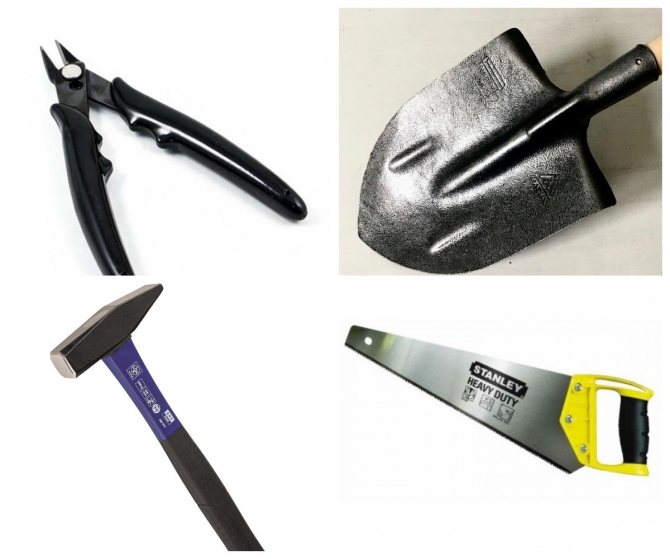

In addition to these tools, you may need additional
Materials (edit)
Material costs can be spread over two years as the vine fills the support gradually as it grows.
The amount of materials required is calculated independently after drawing up a drawing. For the construction of the trellis, you will need pillars as support and wire. You will also need nails or other fasteners.
The posts are the basis of our construction, they can be wooden or metal. In the first case, chestnut, ash, oak are preferable. The bark is removed from the surface of their stems. The lower part of the supports for the purpose of waterproofing 60–80 cm is treated with resin.
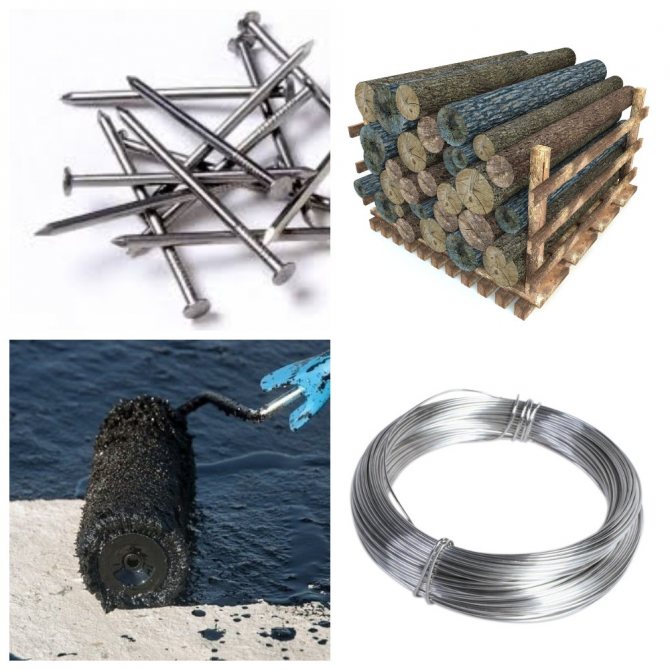

This is the standard set of tapestry materials.
Strengthening strength
The support for the grapes should have a strong crossbar on top. In this case, the pipe diameter may be smaller than that of the support pillars. This is necessary so that the structure can withstand the weight of the vine along with the fruits. If there is no upper crossbar, the support bends, turns out of the ground. A too thin cross-section of the crossbar leads to its deflection. The wire may sag.
The bar can be as little as half an inch in diameter. However, even this will be enough for the structure to retain its shape for a long time.According to experienced gardeners, such supports can last for about three decades or even longer.
It should also be taken into account that the supports must be buried in the ground to a depth of about 60 cm. The hole should be 80 cm deep. Its width and length are also 60 cm. The first 20 cm of the depression must be covered with ordinary sand. Further, the supports are buried in soil, tamping the ground well. A thrust bearing should also be used for the support leg. This will make it harder to shake it.
We make supports
Depending on the needs of gardeners, there are several varieties of trellises. Pipe structures are a simple and affordable type of supports that can be quickly mounted on site without additional assistance. Let's consider the most popular types of supporting structures.
Single-plane trellis
It is recommended to install simple structures in a small area. Optimal placement saves valuable space as other crops can be grown between the single-plane trellis. Pluses of designs:
- uniform ripening of the crop;
- protection from burns;
- excellent aeration;
- good access for care.
How to make a simple pipe support for grapes? For one supporting trellis materials are needed:
- shaped pipes - 4 pcs.;
- wire - 15 m;
- sand;
- cement.
Four holes are dug along the diameter of the pillars and at least 70 cm deep. A layer of sand - 15–20 cm - is poured onto the bottom of the holes. The pipes must stand firmly and not sway, therefore thrust bearings are placed at the base of the supports. Experienced growers recommend cementing the foundation.
Until the solution hardens, do not touch the structure. After 3-4 days, holes are drilled in the pipes for the wire.
Remember: the first layer is 50 cm from the ground, the distance between the subsequent ones is 40 cm. The threads are pulled from the bottom to the top.
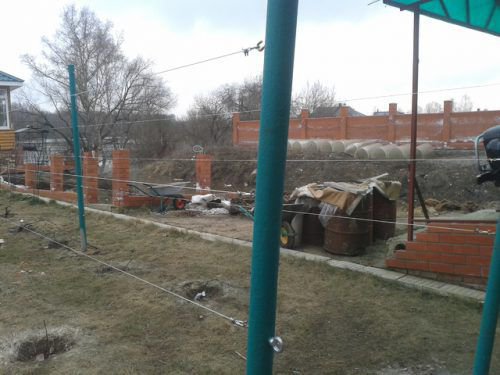

Poles are installed in pits and concreted
Two-plane trellis
If there is enough free space for a vineyard on the site, gardeners prefer to grow powerful bushes with large fruits. To prevent the culture from sagging under the weight of lashes and berries, more complex supports are recommended. Design advantages:
- the plant is illuminated from all sides;
- quick access to bushes;
- natural aeration;
- the possibility of mechanized care;
- long-term preservation of moisture;
- natural formation of lashes, fruits.
Related article: Characteristics of Furor grapes
To make a two-plane trellis, you need materials:
- shaped pipes - 8 pcs.;
- wire - 30 m;
- crossbars - 8 pcs.;
- pegs;
- cement;
- crushed stone.
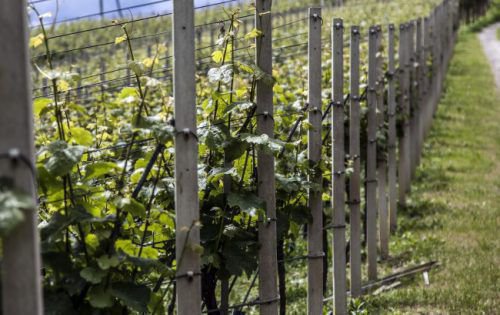

Two-plane trellis suitable for large vineyards
The site is marked with pegs, which are driven in along the edges of the rectangle. A two-plane support consists of two rows of pipes located opposite each other. The posts are straight or angled (for V-trellis). Thick cement is poured into the holes, covered with crushed stone. It is recommended to fix inclined structures at the base with pipe cuttings. In order for the structure to withstand massive bushes, you need to attach the crossbars on top.
Gardeners advise taking copper wire for professional supports. The non-ferrous metal will protect the grapes from mildew. As a last resort, garters made of aluminum or galvanized steel will do. The recommended cross section is from 2 to 4 cm. Such threads are able to withstand the weight of the grapes and not damage the delicate stems.
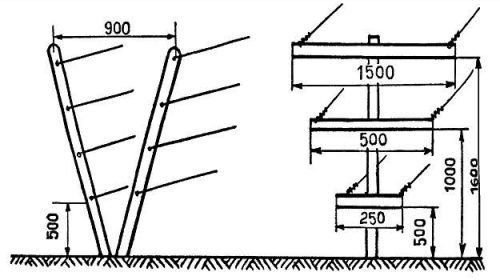

Trellis scheme for grapes
To install the wire on the profile pipes, holes are drilled in the posts with a drill. This is the easiest and most aesthetic way to fix a garter belt. The first row is located 60 cm from the ground, the subsequent ones - every 50 cm, the indent from the crossbars is 5 cm.
Large-fruited powerful lianas bushes are grown in a small area, but this will require Y-shaped trellises. This is a rather complex structure, so helpers are definitely needed. Four pillars are mounted following the example of single-plane supports. A triangle of planks is installed on top, the angle of which reaches 45-60 degrees. Then several rows of wire are pulled.
We examined the available options for trellis for grapes from shaped pipes. Our recommendations will help you choose the right option for a specific site. Thanks to the sufficient amount of light and natural ventilation, the plants will delight gardeners with a bountiful harvest.
Single-plane varieties
The single-plane grape trellis is the simplest type of support. It is easiest to build it on your site. All green mass is located on one support plane. The height of such structures is 1.7-2.2 m. In this case, the growth of the gardener who will take care of the plant should be taken into account.
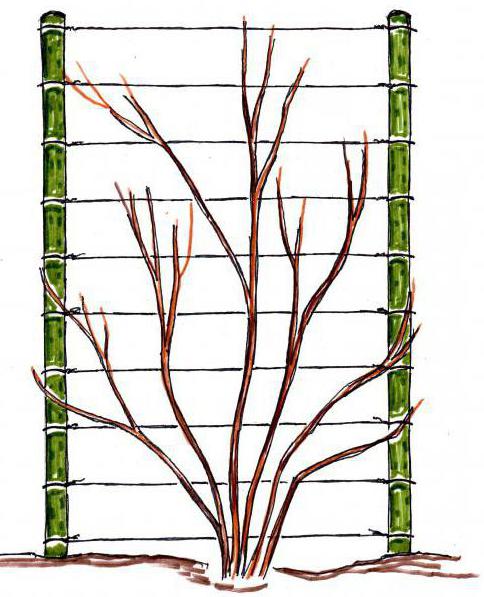

Intermediate supports should be spaced from each other at a distance of 3-4 m. The first wire, which is closest to the ground, should be stretched at a level of 0.5-1 m. Here, as a rule, fruit vine links are located.
The second wire is stretched 25 cm from the first crossbar. The first shoot tie should be done here. Subsequent strands should be spaced about 40-50 cm apart. The rope should be at least 3 mm thick.
To determine the distance between the rows, you need to multiply the height of the trellis by 1.5. This is the minimum value. Better to put the rows a few more centimeters further.
Practical grape net and its dimensions
To make a high-quality hedge for grapes, you need to figure out what its dimensions should be, and also choose the right place for installation.
Vine racks are best positioned north to south. It is with this arrangement of the grid that the berries will be evenly illuminated by the sun's rays throughout the day, and the shade of the leaves will retain the necessary root moisture. The site itself should be sunny.
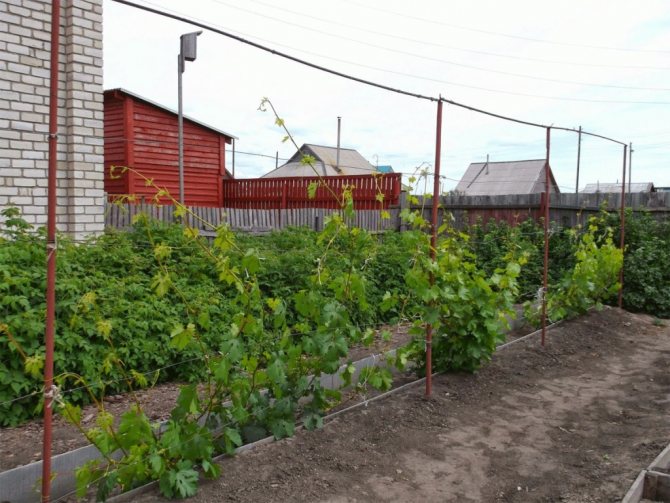

The dimensions of the grape net should be as follows:
- The optimal length is usually 2.5 m;
- The height, as a rule, does not exceed the height of a person, otherwise it will be very difficult to care for fruit vines.
Wooden logs, metal or asbestos-cement pipes can be taken as material for trellises. There is also an option from plastic posts or a wrought-iron canopy. For wire, galvanized steel is the best choice.
When creating vineyards, you need to respect the distance between the planting rows. It must be at least 2 meters.
Two-plane structures
The two-plane grape trellis is most often used for vigorous varieties. This design will allow you to withstand a large mass of shoots, bunches with large berries. Such supports can be used in an area with a small area.
At its core, this design consists of two single-plane trellises. They are combined at the base and divorced at the top (distance 1-1.5 m). All the recommendations presented regarding the arrangement of single-plane varieties are typical for these plants.
The coefficient of the distance between the rows in this case is equal to 2. The height of the trellis is multiplied by it. This determines the minimum distance between the rows.
This design allows for high yields. However, caring for the plant will be difficult. Such a design is more difficult and more expensive to manufacture.
Reliable support for grapes and its types
To keep the grapes under the weight of their own berries and flowers in the spring, you need high-quality support. This design provides uniform heating and ventilation of foliage and fruits, and also makes the care of the crop easier. These supports are called trellises.
So, what they are:
- Single-plane - the simplest designs of several pipes and horizontally tied wire;
- Two-plane - a more complex structure, consisting of two frames connected into one structure;
- Decorative - look like beautiful gazebos, awnings, hedges, pergolas.
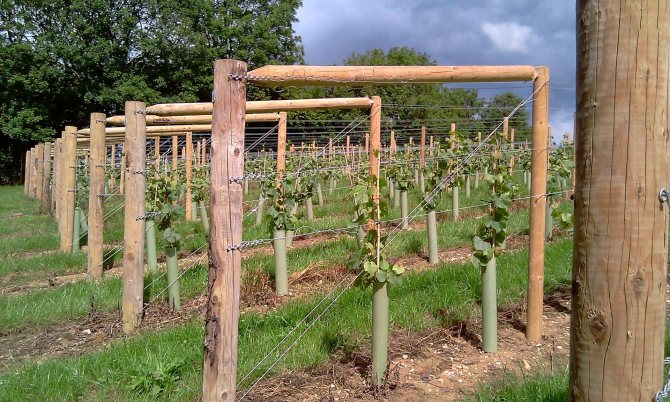

Also, the trellis is able to cover various unsightly places on the site and create shadow where it is needed.
Vine posts can support one plant, or they can support several crops of the same variety.
Arch, gazebo
The formation of a grape bush can also be done for decorative purposes. For this, the structure looks like an arch, gazebo or pergola. In this direction, many varieties of support forms have been invented.
Supports can also form entire tunnels, crossings. Such designs are individual for each vineyard. There are no clear guidelines for organizing the form. It is quite expensive and difficult to build such supports. Plant care is carried out with certain difficulties.
But such designs allow you to decorate the site, as well as get a high yield. This is the most beautiful form of vine growing. There are a great many options for shapes and sizes in this direction. The choice depends on the taste preferences of the owners of the suburban area.
Bush formation
There are several ways to mold a grape bush. The fan-sleeve approach is recognized as one of the most comfortable. The seedlings should be buried in the ground so that the upper peephole is underground at a level of about 7-10 cm. In this case, the likelihood of stem formation is significantly reduced. The vine bends easily with this method of planting to the soil.
If it is required to give the correct shape to the bush, the molding is performed over several years. In the first year, 4 healthy, strong shoots must be grown. Weak vines are removed immediately. In autumn, the plant is shortened to 80-100 cm in height.
The next year the grapes are harvested in the spring. The fan principle is applied. On these branches, you need to grow 2 more shoots. Eyes should be removed immediately after swelling. Only the top two shoots are left. If a crop appears, you do not need to leave more than half of the bunch on the sleeve. In autumn, the buds on the lower shoots are removed.
In the third year, you need to tie up all the shoots horizontally. On the replacement shoot, you need to cut off the inflorescences. Only two are left. One of them is directed away from the center. He will be replaced in a year. In autumn, about 5 kg or more are harvested.
Having considered what size it is necessary to choose the size of the trellis for grapes, you can properly grow this crop on your site.
Erection of a classic wooden pergola
A wooden pergola is a permanent structure, which is not recommended to be disassembled and carried. Decide on the location of the building. A regular grape rack can be mounted in a sunny location. If you want to build a full-fledged gazebo, take into account the factors of wind and rain.
The pergola should be in harmony with the general concept of the suburban area, be built quickly and be easy to design. Simpler structures are more stable and reliable. You will need the following tools:
- drill;
- shovel;
- screwdriver;
- bucket (for mixing cement).
Materials and work progress
Having prepared the necessary tools, start buying materials. You will need both wooden elements and fasteners. Here's a complete list:
- bearing beams (2 pcs., 12 cm in cross section, 2.4 m in length);
- support posts (four three-meter bars of 12-centimeter section);
- four bags of cement;
- cross beams (2 pcs., section 5x10 cm, 2.4 m in length);
- panel trellises;
- wooden lattices;
- fasteners for beams (10 pcs., 5 cm wide);
- screws.
Now you can start making a grape pergola with your own hands. All wood must be treated with antiseptics and paints and varnishes.This will avoid rotting, protect the structure from moisture, mold, temperature extremes and insects. Further procedure:
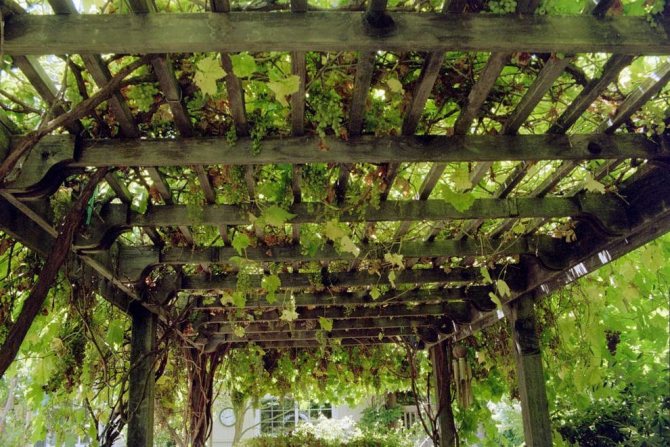

All wood must be treated with antiseptics
- Dig holes for the supports (depth - half a meter).
- Treat the areas of supports buried in the ground with fire or hot bitumen.
- Pour crushed stone (broken brick) into the holes, tamp everything, put the bars and check the level of their verticality.
- Pour concrete, finally level the beams.
- After a day, add earth to the supports, compact everything well.
- Connect the structural elements with self-tapping screws (the diagram is attached).
- Secure the grates (or panel trellises).

